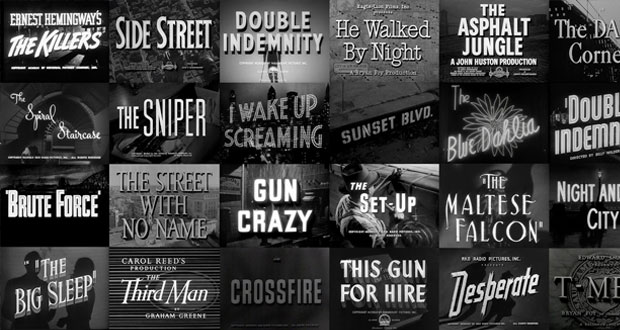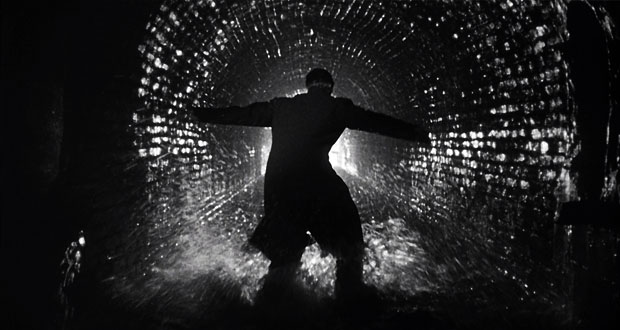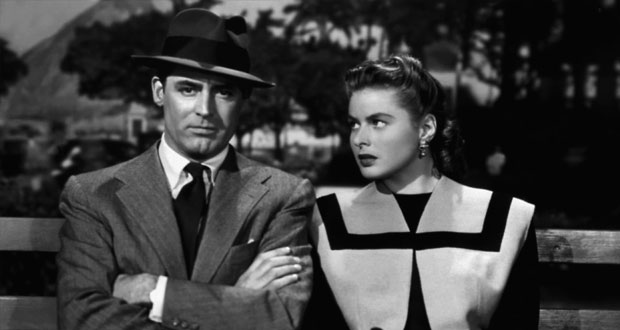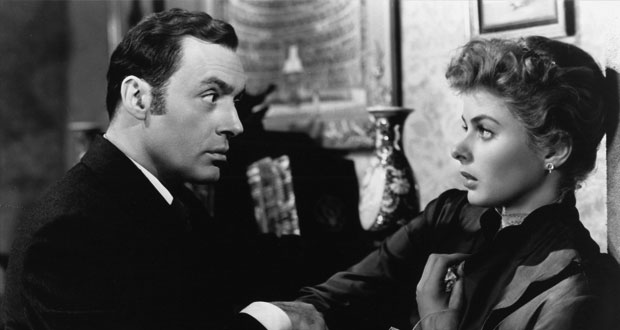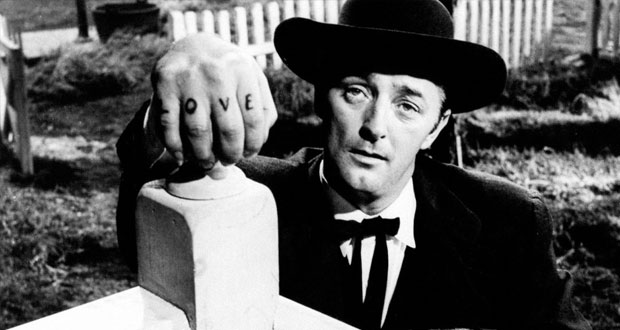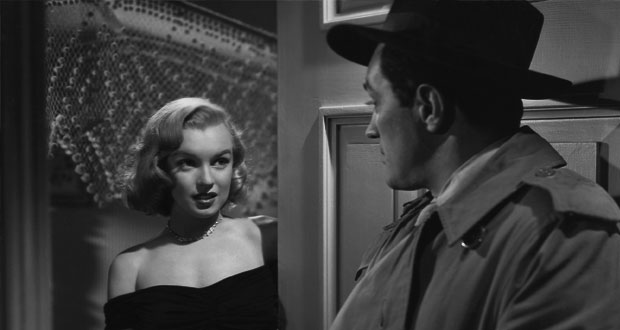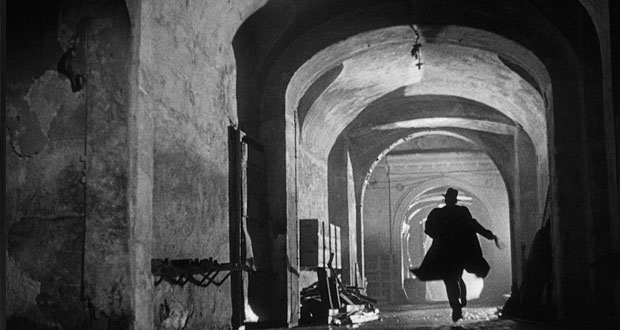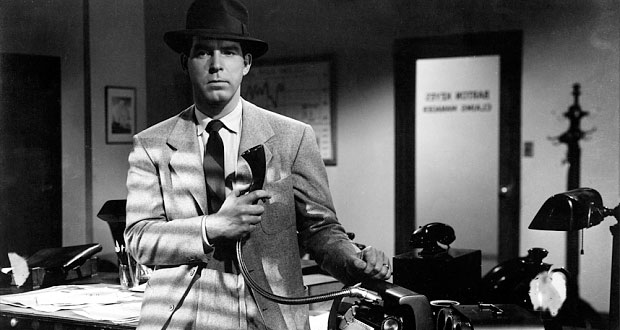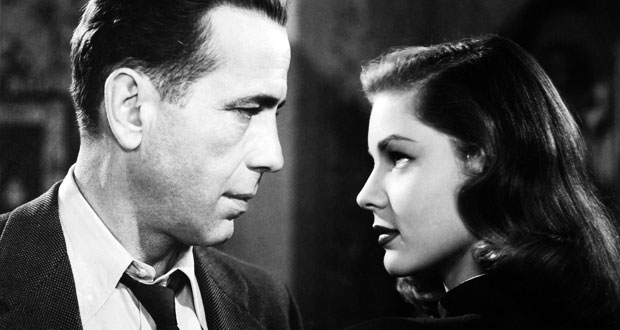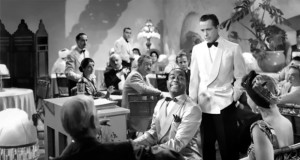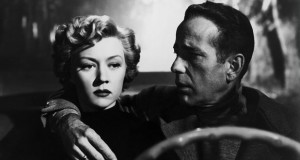Happy Noir-vember!
Film noir (/fɪlm nwɑr/; French pronunciation: [film nwaʁ]) a style or genre of cinematographic film marked by a mood of pessimism, fatalism, and menace. The term was originally applied (by a group of French critics) to American thriller or detective films made in the period 1944–54 and to the work of directors such as Orson Welles, Fritz Lang, and Billy Wilder.
What the heck is film noir? To be honest, there isn’t really a definitive set of criteria that anyone can agree upon. Most people can appreciate the look and feel of film noir when they see it. Think Sam Spade in The Maltese Falcon. Sharp contrast, black and white visuals. Light and shadow. Detectives. Dames. Femme fatales. Cops. Grifters. Money. Lust. Revenge. That sort of thing.
Film noir flourished in a Hollywood era that was governed by the ‘Hays Code‘ where there was strict guidelines on how you could portray crime, sex, infidelity and other subjects deemed morally too sensitive for audiences to handle. Criminals could not be seen to be getting away with their crimes. Couples committing adultery had to receive a come-uppance. Sexual relations outside of marriage was not permitted. Kisses were not allowed to last longer than three seconds.
Film noir was a genre that constantly pushed the limits of what was acceptable and often the way creators skirted around the limitations of the Hays code was innuendo, double entendres and sub text. The dichotomy of creative minds producing films about the basest human desires during a time of moral censorship produced some of the finest films ever made.
This is a list of my ten favourite noir films. I’ve tried to stick to films from the ‘classic’ noir era (1940s to 1950s) so there are plenty of amazing neo noir films – Chinatown, Blood Simple, Memento – which aren’t on this list.
10. Notorious [1946]
One of the most entertaining aspects of Alfred Hitchcock’s Notorious is the incredible contrast between Ingrid Bergman’s virtuous Ilsa Lund in Casablanca, made four years earlier, and her performance as Alicia Huberman in Notorious where she plays the daughter of a Nazi spy who smokes, drinks heavily and is pretty free and easy with the company she keeps.
She is recruited by Devlin, a CIA agent (played by Cary Grant) who sends her on a mission in South America where she must win the affections of Alex Sebastian, a Nazi sympathizer, and uncover his plans to help the Nazis attack the Allies. Complications arise when Devlin develops feelings for Alicia and it becomes unclear whether she will stay to true to the mission and break Devlin’s heart or fall for him and risk exposing her deception to Sebastian.
The film builds a delicate house of cards where each character appears to be manipulating the other with a lie. It all comes to a head in a brilliant final act where an audacious escape is attempted from Sebastian’s house and one false step jeopardizes Alicia’s life. Hitchcock has a ridiculously stacked catalogue of classic films that he directed but this is one of his best.
Notorious is remembered for having ‘the longest kiss in movie history’ during a time when they were only allowed to be three seconds long. You can see how Bergman and Grant got around that here. It was very saucy stuff at the time.
9. Laura [1944]
This is a really lazy thing to do but there’s a paragraph from Roger Ebert’s review of Laura which says it better than I ever could:
Film noir is known for its convoluted plots and arbitrary twists, but even in a genre that gave us “The Maltese Falcon,” this takes some kind of prize. “Laura” (1944) has a detective who never goes to the station; a suspect who is invited to tag along as other suspects are interrogated; a heroine who is dead for most of the film; a man insanely jealous of a woman even though he never for a moment seems heterosexual; a romantic lead who is a dull-witted Kentucky bumpkin moving in Manhattan penthouse society, and a murder weapon that is returned to its hiding place by the cop, who will “come by for it in the morning.” The only nude scene involves the jealous man and the cop.
Otto Preminger’s Laura is a fantastic film that has a glorious cast of misfits and is build around a sublimely weird premise – a policemen in love with a murder victim. Like the best noir films, it has a labyrinthe plot. more twists and revelations than I can ever recall and is a ton of fun right to the very last.
8. Gaslight [1944]
Is Gaslight noir? This is probably the film whose inclusion I debated the most on this list. Let’s call it a ‘gothic noir’.
Set in the Victorian era, it tells the tale of Gregory and Paula, a newly married couple who move into the family home of Paula’s late aunt Alice. As a child, Paula actually witnessed the aftermath of Alicia’s murder when she unwittingly entered the room causing the murderer to flee without possession of the valuable jewels that her aunt owned.
Very quickly, it becomes apparent to the audience that something is not quite right with Gregory who has a powerful hold over Paula. He subtly plays head games with Paula, convicing her that she is losing her mind. He hides her belongings, isolates her from her neighbours, develops her into a hypochondriac and turns the household staff against her (including a teenage Angela Landsbury!).
Gaslight is a brilliant game of psychological brinksmanship between the terrifying Charles Boyer and the sweet natured, vulnerable but ultimate savvy Ingrid Bergman.
7. The Maltese Falcon [1941]
Like Humphrey Bogart’s Casablanca, The Maltese Falcon is a film that most people have already seen and know every key scene and memorable line of dialogue, even if they haven’t watched the film before, thanks to cultural osmosis.
Whether you were a child of the Eighties and saw The Maltese Canary with Tweety and Sylvester or one the other countless spoofs (Teenage Mutant Ninja Turtles, Rugrats, Star Trek, Charmed, Ren and Stimpy all had entire episodes lampooning the film) I think everyone is familiar with the character of Sam Spade, a hard boiled fedora wearing detective who is cold as ice. He doesn’t flinch when he learns that his partner is murdered. He remains impassive when the femme fatale throws herself at him and begs for her life. ” “I hope they don’t hang you, precious, by that sweet neck. . . . The chances are you’ll get off with life. That means if you’re a good girl, you’ll be out in 20 years. I’ll be waiting for you. If they hang you, I’ll always remember you.”
The Maltese Falcon is the cornerstone of noir films as we know them and Humphrey Bogart’s turn as Sam Spade is basically the template for every Hollywood anti-hero ever since. The guys want to be him. The girls want to be with him. It’s iconic imagery, menagerie of colourful crooks (including Sydney Greenstreet and Peter Lorre) and the ridiculous swagger of Bogart make this a timeless film that still holds up today.
6. The Night of the Hunter [1955]
It’s the damnedest thing that Charles Laughton, a legendary actor in Hollywood who has over sixty film credits and starred in the likes of Mutiny on the Bounty and Witness For the Prosecution made precisely one film as a director and it ended up becoming one of the most revered films of its era.
The Night of the Hunter is a sublimely eerie noir thriller in which Robert Mitchum plays Harry Powell, a terrifying serial killer who takes on the guise of a Reverend to win over the trust of his impending victims. You probably know plenty of contemporary characters based on Powell. He has L-O-V-E and H-A-T-E tattooed on his knuckles and he masks his threats in recitations of bible verses.
Powell comes to learn that two young children – John and Pearl – are in possession of a large sum of money that their late father stole during a train robbery. Powell charms his way into the family home and woos the bereaved mother Willa while engaging in a game of cat and mouse with the children.
The Night of the Hunter is an outstanding Southern gothic horror and the performance by Robert Mitchum as Harry Powell won’t soon be forgotten.
5. Asphalt Jungle [1950]
Asphalt Jungle is a film framed entirely from the perspective of a gang of crooks executing a jewel robbery. Directed by the legendary John Huston, the film is noteworthy for its absence of a protagonist, its nihilistic and edgy characters and an uncredited screen appearance from a young, pre-fame Marilyn Munroe. It’s easy to look at Asphalt Jungle and see it as a precursor to many famous crime capers told from the perspective of the perps such as Dog Day Afternoon and Reservoir Dogs.
Being a film made during the Hays Code era, it goes without saying that after the heist is pulled off, the gang eventually comes undone. As the police beat down their door and turn up the heat, half the fun is seeing who cracks first, who stooges on who and who will be the last man standing.
4. The Third Man [1949]
“You know what the fellow said: In Italy for 30 years under the Borgias they had warfare, terror, murder and bloodshed, but they produced Michelangelo, Leonardo da Vinci and the Renaissance. In Switzerland they had brotherly love–they had 500 years of democracy and peace, and what did that produce? The cuckoo clock.”
The Third Man has one of the coolest and most intriguing settings of any film on this list. The film opens as if it were a news reel or a documentary with a narrator setting the stage. It’s post war Vienna and the city has been divided into French, American, British and Russian zones. The American author Holly Martins arrives only to learn that his friend Harry Lime is dead. Only there is no body and no one can adequately explain what happened to him. Instead aBritish officer tells Martins that Lime was a evil man who got what was coming to him and Martins would do best to leave town.
Its a brilliant set up for one of the most loved and revered noir films. It’s made in touching proximity to Warner Brothers’ Casablanca and although both films are about World War II, Casablanca is awash with optimism and patriotism whereas The Third Man is all snarls, cynicism and paranoia. Everyone is out for themselves, you can’t trust what anyone tells you and the good guy doesn’t get the girl. In other words, the perfect recipe for a noir classic.
3. Sunset Blvd. [1950]
“All right, Mr. DeMille, I’m ready for my close-up.”
Sunset Boulevard is a Hollywood film about Hollywood itself. Director Billy Wilder covered a wide range of topics in his illustrious career – alcohol addiction, tabloid journalism, corporations and marriage to name a few – and with Sunset Boulevard he has created one of his most entertainingly dark and morbid comedies about the pursuit of fame and the fleeting glory of Hollywood stardom.
Gloria Swanson, in her most famous role, is mesmerizingly unhinged as Norma Desmond. Her obsession with fame, wealth and the adulation of her peers is only accentuated by the actions of her faithful servant Max who wears a permanently anguished expression on his face, as if he is forever saddened by her fading star. We sense that he understands that Norma’s time in the spotlight will never return but he dutifully complies with her every request and he even writes Norma adoring letters, masquerading as fan mail, to indulge in her charade. They make a hell of a pair.
Part of the fun Billy Wilder has with making a film about Hollywood is his namedropping and use of real studios, real directors and real actors. When Norma Desmond has a bridge night with her washed up old silent actor friends, that’s the real silent movie stars Buster Keaton and H.B Warner that she’s sitting at the table with. When she wants to work in Hollywood again and calls a big shot director, she calls Cecille B.Demille. These little Easter Eggs and kernels of truth that are sprinkled into the storyline only add to the sense of fun Wilder has poking and prodding at his subject matter.
Sunset Boulevard is best described as a tragi-comedy. It is too silly and over the top to take seriously but the performances by Swanson and Erich von Stroheim as her butler Max are so endearingly deranged that you can’t help but get swept up in this merciless satire about the cult of celebrity.
2. Double Indemnity [1944]
As screen writing credits go, you don’t get much bigger names in the Forties than the pairing of Billy Wilder and Raymond Chandler. Wilder is a Hollywood legend with an output of films that were of an improbably high standard across a number of different genres. Then you have Raymond Chandler, a literary giant who only produced eight books in his lifetime but his hard boiled crime detective characters and stylistic prose basically set the foundations for an entire genre. Their collaborative efforts on Double Indemnity do not disappoint. This is a true film noir classic.
The film begins with the longest and most protracted death scene in cinematic history. The victim is insurance salesman Walter Neff, played by Fred MacMurray. Neff gets mortally wounded by a gunshot and then he walks outside, has a conversation with a young man, drives to work in his car, walks into his office, dictates a murder confession that takes ninety minutes to explain and then he keels over dead. What a way to go.
Double Indemnity is a much loved classic of American cinema and with good reason. The film is hugely influential in establishing the visual language, the personalities and the soul of noir cinema. Fred MacMurray and Barbara Stanwyck are captivating leads who wear a vulnerability on their sleeve when they pine for one another but are quick to turn ruthless and cold blooded when their plans fall away and their personal liberty becomes compromised.
Double Indemnity was nominated for seven Academy Awards and won zero. Perhaps it was too dark and nihilistic for the Academy. Double Indemmnity is a nasty film about selfish people doing unspeakable things to get what they desire. The very essence of film noir.
1. The Big Sleep [1946]
The Big Sleep, Howard Hawks adaptation of Raymond Chandler’s most famous literary work, makes almost no sense. There’s a famous Hollywood anecdote which Lauren Bacall tells in her autobiography where Humphrey Bogart approaches Hawks and asks ‘who pushed Taylor off the pier?’. The production grinded to a halt as the cast and crew debated the answer. This might sound like major cause for concern and yet anyone who has seen the film will tell you it doesn’t matter in the slightest. This is a film that is ‘all about the investigation, not the results.’
Private detective Phillip Marlowe is tasked by a ailing, wealthy octogenarian General Sternwood to resolve the debts of his young daughter Carmen to the bookseller Arthur Geiger who has gone missing. Before Marlowe leaves the mansion, he is stopped by Carmen’s older sister Vivien who tells him her fathers intentions are not what they seem. The story never gets any clearer from there.
Marlowe goes on one hell of a journey – crossing paths with gamblers, blackmailers, pornographers and crooks – as well as some of the most beautiful women to ever grace the silver screen. I can’t really overstate this point. The Big Sleep has got to have one of the most absurdly photogenic cast of women I have ever seen and all of them delivers lines of dialogue that are dripping with sexual innuendo and double entendres. Even the assistant book keeper (Dorothy Malone) that Marlowe meets for a single scene basically steals the goddamn movie with her body language and flirtation. Allegedly we were spared any more footage than the single scene we get because Bacall was irate with the chemistry Malone had onscreen with Bogart.
Film noir is mostly the same story told over and over again from only slightly differing characters and perspectives. So what makes one better than the rest? It’s the characters, the chemistry and how it all comes together. And film noir doesn’t get any better than Lauren Bacall teasing Humphrey Bogart with lines like “You know how to whistle, don’t you, Steve? You just put your lips together and blow.” They would’ve been falling out of their seats and rolling down the aisles.
The Big Sleep brings to life Raymond Chandler’s inimitable prose in a way that hasn’t been bettered before or since. It is one of those films where every line just works. The banter – “You’re not very tall are you?” “I try to be”. The saucy playfulness – “She tried to sit on my lap when I was standing up”. The poetic melodrama – “Ugh. Nasty things [orchids]. Their flesh is too much like the flesh of men, and their perfume has the rotten sweetness of corruption.” And the hard boiled grit – “Is that any of your business?” “I could make it my business”
There is something about The Big Sleep that works for me in a way that I find difficult to fully articulate. It is an incredible film in its own right but it is also the template for my favourite film of all time – The Coen Brother’s The Big Lebowski. When you have a film with such strong characters throwing barbed one liners and exchanging witticisms the way they do in these films, thats all I really need. I love the film noir genre dearly and although I have plenty more on my wishlist to see, for now The Big Sleep sits at the top of the heap as my favourite. It doesn’t get any better than this.
 The FAT Website est. 1999
The FAT Website est. 1999

